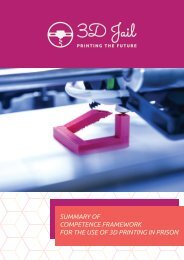3D Jail Project - IO1 - Competence framework for 3D printing in jail
Intellectual Output 1 The main innovative element of IO1 is to entail professionalizing competencies on the use of 3D printing technologies in the learning context of people with fewer opportunities because of their status of prisoners, ex-prisoners or subjected to alternative measures to detention. It is innovative because – in a pioneering way in Europe – it puts the basis to frame this kind of competencies in relation with restricted people, in the context of prison security, and it challenges penitentiary administrations to innovate their procedures and conditions to use even more ICT technologies inside their structures. It also poses prisons’ educational systems before the challenge to include these specific competencies in the educational experience of the inmates.
Intellectual Output 1 The main innovative element of IO1 is to entail professionalizing competencies on the use of 3D printing technologies in the learning context of people with fewer opportunities because of their status of prisoners, ex-prisoners or subjected to alternative measures to detention. It is innovative because – in a pioneering way in Europe – it puts the basis to frame this kind of competencies in relation with restricted people, in the context of prison security, and it challenges penitentiary administrations to innovate their procedures and conditions to use even more ICT technologies inside their structures. It also poses prisons’ educational systems before the challenge to include these specific competencies in the educational experience of the inmates.
- No tags were found...
You also want an ePaper? Increase the reach of your titles
YUMPU automatically turns print PDFs into web optimized ePapers that Google loves.
Def<strong>in</strong>ition of areas of employment<br />
Develop a tra<strong>in</strong><strong>in</strong>g <strong>for</strong> Additive Manufactur<strong>in</strong>g<br />
The aim of <strong>3D</strong> <strong>Jail</strong> – Pr<strong>in</strong>t<strong>in</strong>g the future is the professional re<strong>in</strong>tegration of <strong>in</strong>mates <strong>in</strong>to the<br />
labour market. As we already stated <strong>3D</strong>-Pr<strong>in</strong>t<strong>in</strong>g is still a new technology, which has already<br />
been adapted with<strong>in</strong> some workflows but hasn’t developed as a profession <strong>in</strong> and of itself<br />
yet. There<strong>for</strong>e, we can’t transfer the content directly from already exist<strong>in</strong>g professions and<br />
certifications.<br />
Still – the skills which are needed are the construction of objects and technical draw<strong>in</strong>gs <strong>in</strong><br />
a CAD-Software, the preparation of the pr<strong>in</strong>t and its sett<strong>in</strong>gs – the CAM-Manufactur<strong>in</strong>g part<br />
– and the operation of the mach<strong>in</strong>e itself. In this last step the <strong>pr<strong>in</strong>t<strong>in</strong>g</strong>-process must be<br />
watched from time to time, to see if the pr<strong>in</strong>t-sett<strong>in</strong>gs have been carried out correctly or if<br />
adjustments are needed.<br />
All these aspects can be found and/or are part of already exist<strong>in</strong>g professions and their<br />
tra<strong>in</strong><strong>in</strong>g. There<strong>for</strong>e, we can pick the needed tra<strong>in</strong><strong>in</strong>g aspects from different educational<br />
courses and <strong>for</strong>m a new tra<strong>in</strong><strong>in</strong>g course, suitably adjusted to needs of the project. Below, a<br />
list of the professions we can use as guidel<strong>in</strong>es and the different qualifications needed <strong>for</strong><br />
them. By look<strong>in</strong>g at the educational paths of these jobs we can start to orientate and then<br />
adapt them <strong>in</strong>to our own tra<strong>in</strong><strong>in</strong>g, also beg<strong>in</strong>n<strong>in</strong>g to understand how we could certificate<br />
the taught competences. Also, some educational paths – as <strong>for</strong> example „Application<br />
Eng<strong>in</strong>eer <strong>for</strong> Additive Manufactur<strong>in</strong>g “– have been developed recently and give a clearer<br />
idea about the content and skills to be developed dur<strong>in</strong>g the course of <strong>3D</strong><br />
CAD<br />
Def<strong>in</strong>ition<br />
Needed Skills<br />
Draw<strong>in</strong>g and Construction of digital objects<br />
Knowledge and of CAD-Software<br />
Reference to Reality and dimensions<br />
CAM<br />
Def<strong>in</strong>ition<br />
Needed Skills<br />
Programm<strong>in</strong>g the mach<strong>in</strong>e to produce a digital object<br />
Knowledge of CAM-Software<br />
Possibilities of the mach<strong>in</strong>e<br />
Material<br />
Production<br />
Def<strong>in</strong>ition<br />
Skills<br />
Watch the production process<br />
Feedback to CAD & CAM if someth<strong>in</strong>g goes wrong<br />
Possibilities and limitations of mach<strong>in</strong>e<br />
Technical Knowledge of mach<strong>in</strong>e and tools<br />
23





